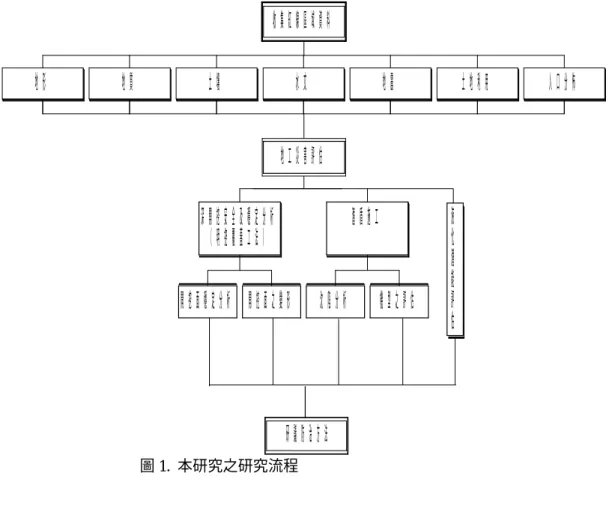一、中文摘要(關鍵詞:) 地盤災害、捷運系統、
台南地區
台南捷運系統已完成規劃,其中綠線佈設於 新化鎮、永康市及台南市,將是未來台南都會區 不可或缺之交通路線。
本研究乃針對綠線沿線進行地工災害分析 並研議防治方法,研究內容為(1)蒐集綠線沿線 區域資料,包括地形、地質、地震、水文及人文資 料。(2)以經驗方法進行沿線地工災害分析,包 括開挖面穩定、開挖引致之沉陷、潛盾施工引致 之沉陷、土壤液化潛能及土壤液化引致之沉陷。
(3)根據分析結果建立沿線地工災害發生敏感區 段圖,並針對可能發生之地工災害研擬具體可行 之防治方法。
研究分析結果顯示,以明挖覆蓋工法施工區 段之地表沉陷影響範圍約為開挖深度 2~3.8 倍,而 潛盾工法施工區段其地表沉陷影響範圍約為開挖 深度 2 倍。在液化潛能及液化引致沉陷分析方面,
於成功路與海安路交會處附近路段液化潛能最 高,沉陷量亦最大,而在台南火車站附近液化潛 能最低。根據上述分析結果研擬可行之災害防治 方法,期能供未來綠線施工時之參考。
Abstr act
Rapid Mass Transit System of Tainan Metropolitan has been planned. The Green Line in the system will connect Hsin-Hwa, Yun-Cun and Tainan. The line will be an indispensable main route in the communication network of Tainan Metropolitan.
The purpose of this project is to evaluate the potential geologic hazards along the Green Line of the Rapid Mass Transit System of Tainan Metropolitan and to purpose the preventive and remedial methods of those hazards. The procedures of the evaluation includes (1) collection of the basic information related to the topography, geology, hydrology and society, (2) evaluation of the geologic hazards along the Line, such as; stability of the excavation, settlement due to the excavation and due to the shield tunneling, potential of the soil liquefaction. (3) propose of the remedial methods of those potential hazards.
Some conclusions of this project are drawn as follows:
(1) the radii of the influent area of settlement due to the open excavation is 2 to 3.8 time of the depth of the excavation and the radii of the influent area of settlement due to the shield tunneling is about 2 of the depth of the excavation, (2) the higher potential of soil liquefaction is at intersection of Cheng Kung and Hai An Roads, the lower potential of soil liquefaction is at Tainan Station.
二、研究動機與目的
台南捷運綠線路段之潛在地盤災害調查及其防治方法研究 Investigation of the Potential Geologic Hazards along the Green Line in the
Rapid Mass Transit System of Tainan Metropolitan
計劃編號:(NSC 89-2211-E-006-055) 執行期限:88/08/01-89/07/31
主 持 人:陳景文 國立成功大學土木工程學系
台灣地狹人稠,經濟型態由農業型態轉為工 商型態,人口集中於都會地區,更由於國人經濟 能力的提高,小型車大幅成長,都會區交通問題 更形惡化,台南都會區亦不例外,台南捷運系統 的規劃將有助於解決日益嚴重的交通問題。
台南捷運系統初步規劃將採用鋼輪、鋼軌小 斷面的都會捷運系統,由紅線、綠線及藍線三條 路線構成。其中綠線規劃為第一期路網之一,北 起新化鎮,沿台 20 省道經永康市,在台南火車站 西轉成功路進入台南市區,規劃路線總長 16.6 公 里,全線以地下形式建造,佈設地下車站 13 座,
建造完成後除可紓解未來台南都會區日漸飽和的 交通流量,更是聯絡台南都會區及衛星城市之重 要交通路線,配合南二高及高速鐵路的建造,綿 密而完整的交通網將加速台南都會區之發展,並 可擴大台南都會區之範圍。
捷運綠線涵蓋新化鎮、永康市及台南市,範 圍廣大,沿線地質狀況頗為複雜,對於擬採用明 挖覆蓋工法及潛盾工法施工之綠線而言,地工災 害之控制,為綠線施工順利與否之重要關鍵。以 台北捷運為例,地工災害的發生除了造成工程進 度的嚴重落後以及影響施工品質外,對於民眾的 生命財產安全更是一大威脅。此外台灣因位處環 太平洋地震帶,地震發生次數頻繁,綠線沿線區 域附近尚有左鎮斷層、新化斷層及後甲里斷層,
地震災害對於捷運綠線施工及營運的影響亦不容 忽視,應加以防範。故本研究將針對綠線沿線潛 在地工災害預先進行分析,對於可能發生之地工 災害研擬具體之防治方法,供未來台南捷運綠線 施工時參考。
三、研究方法與流程
研究內容主要可分成三部份,第一部份為蒐 集綠線沿線區域資料,包括地形、地質、地震、水 文、人文資料。第二部份為採用學者所提出之經
驗方法進行沿線地工災害分析,包括開挖面穩 定、開挖引致之沉陷、潛盾施工引致之沉陷、土 壤液化潛能、土壤液化引致之沉陷。第三部份則 是根據分析結果建立沿線地工災害發生敏感區 圖,並針對可能發生之地工災害研擬具體可行之 防治方法。研究流程請參見圖 1。
四、結論與建議
4.1 結論
本研究針對台南捷運綠線沿線區域進行地工 災害分析,結論分述如下:
1.台南捷運綠線沿線區域之土層主要為現代沖積 層,以砂質粉土、粉土質砂與粉土質黏土為主。
2.在擋土壁體變形引致地表沉陷方面,沉陷影響範 圍約為開挖深度 2~3.8 倍。
3.開挖面穩定分析結果可得壁體貫入深度約為開 挖深度之 1.6∼1.8 倍左右,而開挖深度為 10 公尺時最容易發生上舉與隆起現象,砂湧分析 則均為安全。
4. 以 Peck-Fujita 法分析潛盾施工所造成之沈陷,
沉陷影響範圍約為開挖深度 2 倍。
5. 捷運綠線沿線區域液化潛能評估結果顯示,以 G7~G9 站(成功路與海安路交會處附近)區段 最易發生液化,而以 G6~G7 站(開元路至台南 火車站附近)區段最不容易發生液化。
6. 捷運綠線沿線區域液化引致沉陷評估結果顯 示,液化潛能較高地區沉陷量較大, G7~G9 站(成功路與海安路交會處附近)區段為沿線 區域沉陷量較大區段。
4.2 建議
1.捷運綠線區域之深開挖案例並不多,且沿線土層 資料蒐集不易,本研究以有限資料進行分析,
分析結果只能當作此區域開挖施工時參考,建
議在捷運綠線施工時,詳細蒐集開挖時之監測 值,並配合數值模擬,找出符合此區域的分析 模式,供其他路線分析。
2.在潛盾隧道施工方面,台南地區潛盾施工案例甚 少,各學者所提出經驗公式差異甚大,對預測 準確性影響很大,建議本研究之結果只能當作 初步之參考,必須於往後潛盾隧道施工時,詳 細蒐集實測資料,並配合數值模擬,找出符合 此區域之沈陷槽模式,供其他路線分析。
3.本研究所採用之液化分析乃採用國外學者所建 議之方法,建議蒐集更多本土性液化案例配合 電腦分析,找出符合此區域之液化分析模式。
五、參考文獻
1. 交通部,公路橋樑耐震設計規範,交通技術 標準規範公路類工路工程部,幼獅出版社,
台北(1995)。
2. 朱旭、楊慕泉、段紹緯,「潛盾施工管理」,
第七屆大地工程學術研究討論會,台北,第 1033-1040 頁 (1997)。
3. 何春蓀,台灣地質圖說明書,經濟部中央地 質調查所,台北 (1986)。
4. 何泰源、李魁士,「深開挖引致地表沈陷及 建物保護」,現代營建,第 129 期,第 17-24 頁(1990)。
5. 吳偉特,「台北都會區捷運系統地區不同最 大地表加速度之土壤液化潛能」,財團法人 台灣營建研究中心 (1987)。
6. 紀雲曜,「高雄縣永安沿海地區沖積層下陷 及其潛能評估方法之研究」,國立成功大學 土木工程研究所博士論文,台南(1997)。
7. 倪勝火,電腦輔助大地工程試驗法與分析,
第 411-449 頁 (1994)。
8. 秦中天、黃立煌,「深開挖施工地下水控制」,
地工技術,第 63 期,第 15-22 頁 (1997)。
9. 財團法人中興工程顧問社,「地工技術研發- 深開挖分析探討」,專案研究報告 (1996)。
10. 國家地震工程研究中心,台灣地區高速鐵路 地震及耐震設計準則計畫,交通部高速鐵路 工程籌備處,台北 (1992)。
11. 黃俊鴻、陳正興,「土壤液化評估規範之回 顧與前瞻」,地工技術,第 70 期,第 23-44 頁 (1998)。
12. 歐章煜、吳昭慧、唐雨耕,「大台北深開挖 技術整合(第一期)」,國立台灣工業技術 學院,專案研究計畫 (1997)。
13. 謝旭昇、王崑瑞,「地下室開挖地下水之處 理」,地工技術,第 63 期,第 5-14 頁 (1997)。
14. Fujita, K.,〝Prediction of Settlements by Shield Tunneling 〞 Proceedings, International Conference of Soil Mechanics, Mexico, Vol.1, pp. 239-246 (1982).
15. Hsieh, P. G. and Ou, C.Y., 〝 Prediction of Ground Settlement Caused by Excavation 〞 Paper Submitted to Journal of the Geotechnical Engineering ASCE (1996).
16. Ishihara, K. and Yoshimi, M., “Evaluation of Settlement in Sand Deposits Following Shear Loading,”Soils and Foundations, Vol.32, No.1 pp. 178-188 (1992).
17. Iwasaki, T., Arakawa, T. and Tokida, K.,
〝 Simplified Procedures for Assessing Soil Liquefaction during Earthquakes 〞 Soil Dynamics and Earthquake Engineering Conference, Southampton, pp.925-939 (1982).
18. Iwasaki, T., Tatsuoka, F., and Yasuda, S.,〝A Practical Method for Assessing Soil Liquefaction Potential Based on Case Studies at Various Sites in Japan〞Proceedings, Second International Conference Microzonation Safer Construction Research Application, Vol. 2, pp.
885-896 (1978).
19. Liao, S. C. and Whitman, R. V.,〝Overburden Correction Factors for SPT in Sand〞Journal of Geotechnical Engineering, ASCE, Vol. 112, No.GT3, pp. 373-377 (1986).
20. Peck, R. B.,〝Deep Excavation and Tunneling in Soft Ground Soil 〞Proceedings of the 7th International Conference on Soil Mechanics and Foundation Engineering, State of- the- Art- Volume, Mexico City ,pp.225-290 (1969).
21. Seed, H. B. and Idriss, I. M., 〝 Simplified Procedure for Evaluating Soil Liquefaction Potential〞Journal of the Soil Mechanics and Foundations Division, ASCE, Vol. 97, No. SM9, pp. 1249-1273 (1971).
22. Seed, H. B., Tokimatsu, K., Harder, L. F. and Chung, R. M.,〝Influence of SPT Procedures in Soil Liquefaction Resistance Evaluations, 〞 Journal of Geotechnical Engineering, ASCE, Vol. 111, No.12, pp. 1445 (1985).
23. Seed, H. B.,〝Evaluation of Soil Liquefaction Effects on Level Ground During Earthquakes〞
State of the Art paper, Liquefaction Problems in Geotechnical Engineering, pp. 1-104 (1976).
24. Tokimatsu, K. and Yoshimi, Y., 〝 Empirical Correlation of Soil Liquefaction Based on SPT N-Value and Fines Content 〞 Soils and Foundations, JSSMFE, Vol. 23, No.4, pp. 56- 71(1983).
25. Yoshimi, Y.,〝Ductility Criterion for Evaluating Liquefaction Remediation Measures 〞Tsuchi- to-kiso JSSMFE, Vol.36, No.6, pp.33-38 (1990).
圖 1. 本研究之研究流程
研議防治方法
液 化 潛 能 評 估
地形 地質 土壤 水文 地震 土地利用 人口分佈
開挖面穩定分析 開挖面之變形 深開挖安全及穩定分析
(明挖覆蓋工法)
沈陷分析 機型之評估 潛盾施工 地工災害評估
收集紅線區域資料
